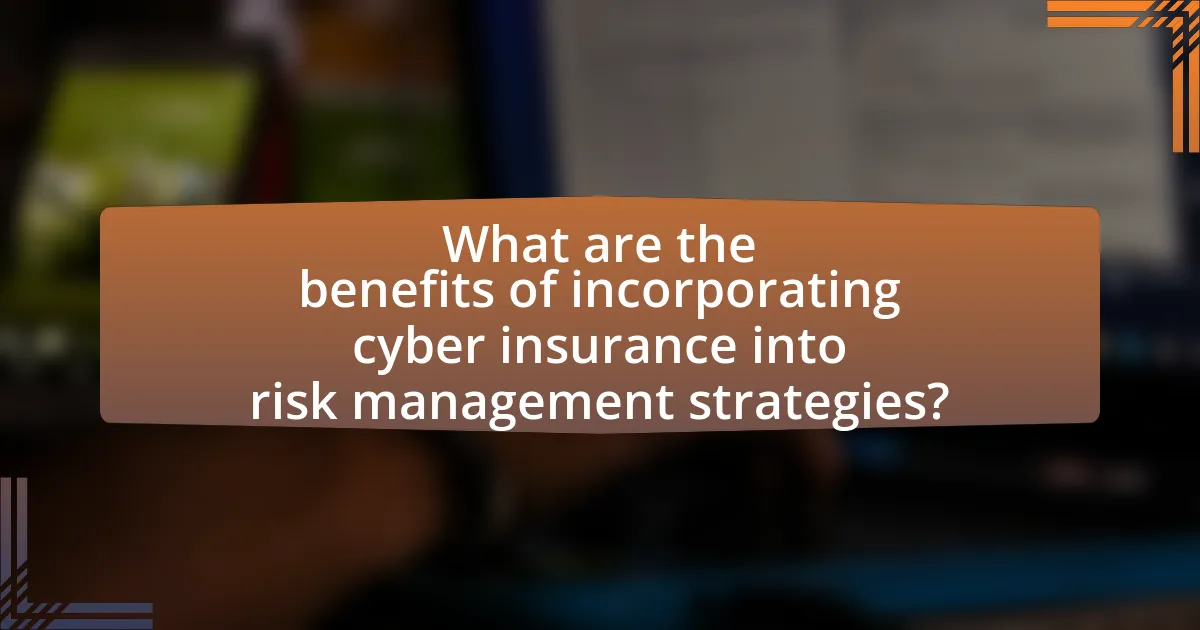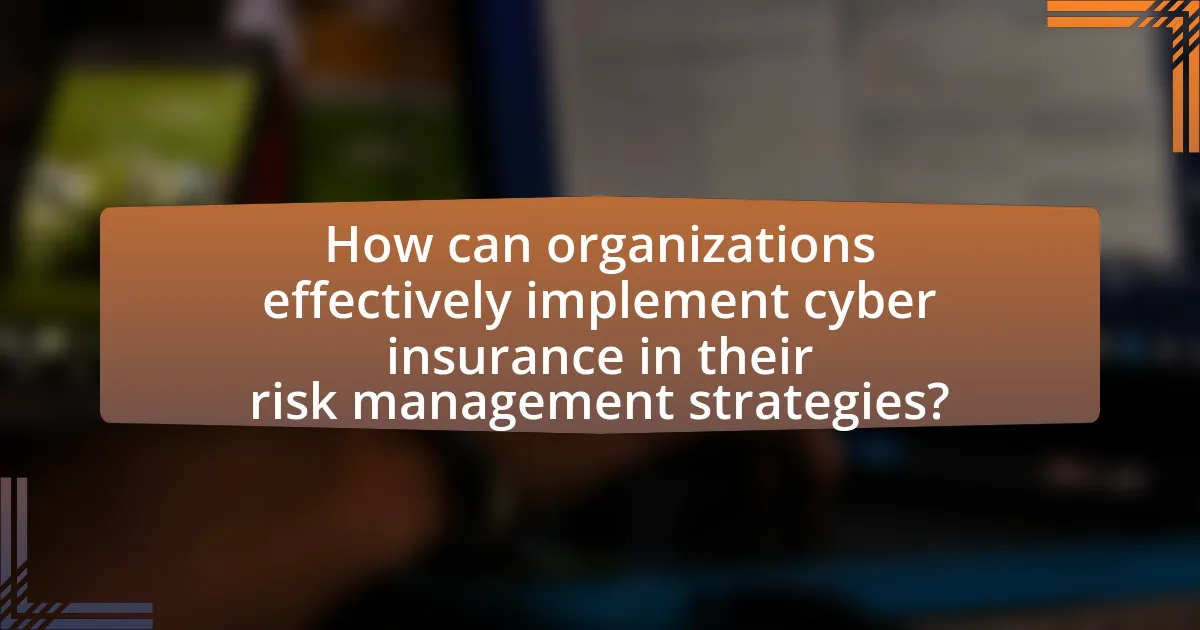Cyber insurance is a vital component of risk management strategies, providing financial protection against losses from cyber incidents such as data breaches and ransomware attacks. The article outlines how cyber insurance integrates into overall risk management frameworks, detailing key policy components like data breach coverage and business interruption. It emphasizes the increasing necessity of cyber insurance for businesses facing rising cyber threats and discusses its role in incident response planning and recovery efforts. Additionally, the article addresses common misconceptions, limitations of coverage, and best practices for effectively implementing cyber insurance to enhance organizational resilience against cyber risks.

What is the Role of Cyber Insurance in Risk Management Strategies?
Cyber insurance plays a critical role in risk management strategies by providing financial protection against losses resulting from cyber incidents. This type of insurance helps organizations mitigate the financial impact of data breaches, ransomware attacks, and other cyber threats, allowing them to recover more quickly and effectively. According to a report by the Ponemon Institute, the average cost of a data breach in 2021 was $4.24 million, highlighting the significant financial risks that cyber insurance can help address. By transferring some of the financial risks associated with cyber threats to an insurance provider, businesses can allocate resources more efficiently and focus on strengthening their overall cybersecurity posture.
How does cyber insurance fit into overall risk management frameworks?
Cyber insurance is a critical component of overall risk management frameworks as it provides financial protection against losses resulting from cyber incidents. By integrating cyber insurance into risk management strategies, organizations can transfer some of the financial risks associated with data breaches, ransomware attacks, and other cyber threats. This integration allows businesses to better allocate resources for risk mitigation, as they can rely on insurance coverage to handle potential financial impacts. According to a report by the Ponemon Institute, organizations with cyber insurance are more likely to have a comprehensive risk management strategy, as they are incentivized to implement stronger security measures to reduce premiums and claims.
What are the key components of a cyber insurance policy?
The key components of a cyber insurance policy include coverage for data breaches, business interruption, network security liability, and crisis management expenses. Data breach coverage protects against costs associated with unauthorized access to sensitive information, while business interruption coverage compensates for lost income due to cyber incidents. Network security liability addresses legal claims arising from security failures, and crisis management expenses cover public relations efforts and notification costs. These components are essential for mitigating financial losses and managing risks associated with cyber threats.
How do these components interact with risk management practices?
Cyber insurance components interact with risk management practices by providing financial protection and risk mitigation strategies against cyber threats. These components, including policy coverage, risk assessment, and incident response, work together to enhance an organization’s ability to manage potential losses from cyber incidents. For instance, a comprehensive cyber insurance policy can cover costs related to data breaches, legal fees, and business interruption, thereby reducing the financial impact on the organization. Additionally, insurers often require businesses to implement specific security measures as a condition of coverage, which further strengthens their overall risk management framework. This interaction is supported by data indicating that organizations with cyber insurance are more likely to adopt proactive cybersecurity measures, leading to a decrease in the frequency and severity of cyber incidents.
Why is cyber insurance becoming essential for businesses?
Cyber insurance is becoming essential for businesses due to the increasing frequency and severity of cyberattacks, which can lead to significant financial losses. In 2021, the average cost of a data breach was $4.24 million, according to IBM’s Cost of a Data Breach Report. This financial impact, coupled with regulatory requirements for data protection, makes cyber insurance a critical component of risk management strategies. Additionally, as businesses increasingly rely on digital operations, the potential for operational disruption from cyber incidents underscores the necessity of having coverage to mitigate these risks effectively.
What types of cyber threats are businesses facing today?
Businesses today face several types of cyber threats, including ransomware attacks, phishing schemes, data breaches, and insider threats. Ransomware attacks involve malicious software that encrypts a company’s data, demanding payment for decryption, with a reported increase of 150% in such incidents from 2019 to 2020 according to the Cybersecurity and Infrastructure Security Agency (CISA). Phishing schemes trick employees into revealing sensitive information, with the Anti-Phishing Working Group reporting over 200,000 unique phishing sites in 2020. Data breaches expose confidential information, affecting millions of records, as seen in the 2021 Facebook breach where data from 530 million accounts was leaked. Insider threats arise from employees misusing access to sensitive data, contributing to 34% of data breaches according to the Ponemon Institute’s 2021 Cost of Insider Threats Global Report. These threats highlight the critical need for robust cyber insurance and risk management strategies.
How can cyber insurance mitigate the financial impact of these threats?
Cyber insurance can mitigate the financial impact of cyber threats by providing coverage for losses incurred from data breaches, ransomware attacks, and other cyber incidents. This financial protection helps organizations recover from the costs associated with incident response, legal fees, regulatory fines, and business interruption. For instance, a report by the Ponemon Institute indicates that the average cost of a data breach in 2021 was $4.24 million, highlighting the significant financial burden that cyber incidents can impose. By transferring some of this risk to an insurance provider, businesses can stabilize their financial standing and allocate resources more effectively in the aftermath of a cyber event.

What are the benefits of incorporating cyber insurance into risk management strategies?
Incorporating cyber insurance into risk management strategies provides financial protection against losses resulting from cyber incidents. This type of insurance helps organizations mitigate the financial impact of data breaches, ransomware attacks, and other cyber threats by covering costs such as legal fees, notification expenses, and business interruption losses. According to a report by the Ponemon Institute, organizations with cyber insurance reported a 30% reduction in the financial impact of cyber incidents compared to those without coverage. Additionally, cyber insurance often includes access to risk management resources and expertise, which can enhance an organization’s overall cybersecurity posture.
How does cyber insurance enhance organizational resilience?
Cyber insurance enhances organizational resilience by providing financial protection and resources to recover from cyber incidents. This financial backing allows organizations to mitigate the economic impact of data breaches, ransomware attacks, and other cyber threats, enabling quicker recovery and continuity of operations. For instance, a report by the Ponemon Institute indicates that organizations with cyber insurance can reduce the average cost of a data breach by approximately 30%. Additionally, cyber insurance policies often include access to expert resources, such as incident response teams and legal counsel, which further strengthens an organization’s ability to respond effectively to cyber threats.
What role does cyber insurance play in incident response planning?
Cyber insurance plays a critical role in incident response planning by providing financial support and resources to organizations facing cyber incidents. This type of insurance helps cover costs associated with data breaches, including legal fees, notification expenses, and public relations efforts, which can be substantial. According to a report by the Ponemon Institute, the average cost of a data breach in 2021 was $4.24 million, highlighting the financial impact that cyber incidents can have on organizations. Additionally, many cyber insurance policies offer access to expert incident response teams, which can assist in managing and mitigating the effects of a cyber attack. This combination of financial backing and expert resources enables organizations to respond more effectively to incidents, minimizing damage and recovery time.
How can it support recovery efforts after a cyber incident?
Cyber insurance can support recovery efforts after a cyber incident by providing financial resources to cover the costs associated with data breaches, system repairs, and legal liabilities. This financial backing enables organizations to quickly restore operations and mitigate the impact of the incident. For instance, a study by the Ponemon Institute found that organizations with cyber insurance reported a 30% faster recovery time compared to those without coverage, highlighting the effectiveness of insurance in facilitating prompt recovery.
What are the limitations of cyber insurance in risk management?
Cyber insurance has several limitations in risk management, primarily including coverage gaps, policy exclusions, and the evolving nature of cyber threats. Coverage gaps often arise because many policies do not cover certain types of cyber incidents, such as those resulting from human error or insider threats. Additionally, policy exclusions can limit the scope of protection, leaving organizations vulnerable to specific risks that are not addressed in their insurance contracts. The rapidly changing landscape of cyber threats further complicates risk management, as insurers may struggle to keep policies updated to reflect new vulnerabilities and attack vectors. According to a report by the Insurance Information Institute, many businesses find that their cyber insurance does not fully align with their risk profiles, highlighting the need for a comprehensive risk management strategy that goes beyond insurance alone.
What common misconceptions exist about cyber insurance coverage?
Common misconceptions about cyber insurance coverage include the belief that it provides complete protection against all cyber threats and that it eliminates the need for robust cybersecurity measures. In reality, cyber insurance typically covers specific incidents, such as data breaches or ransomware attacks, but does not cover all types of cyber risks. Additionally, insurers often require organizations to maintain certain cybersecurity practices to qualify for coverage, emphasizing that insurance is not a substitute for proactive security measures. According to a 2021 report by the Cyber Insurance Market, 60% of businesses mistakenly think that having cyber insurance alone will safeguard them from all cyber incidents, which is misleading and can lead to inadequate risk management strategies.
How can businesses ensure they are adequately covered?
Businesses can ensure they are adequately covered by conducting a comprehensive risk assessment to identify potential vulnerabilities and threats. This assessment allows businesses to understand their specific risks and determine the appropriate level of cyber insurance needed. According to a report by the Ponemon Institute, organizations that regularly assess their cybersecurity posture are 50% more likely to have adequate insurance coverage. Additionally, businesses should work with insurance providers to tailor their policies to cover specific risks, ensuring that they are not underinsured. Regularly reviewing and updating insurance policies in response to evolving threats is also crucial for maintaining adequate coverage.

How can organizations effectively implement cyber insurance in their risk management strategies?
Organizations can effectively implement cyber insurance in their risk management strategies by conducting a thorough risk assessment to identify vulnerabilities and potential losses. This assessment allows organizations to select appropriate coverage that aligns with their specific risk profile. For instance, a 2021 report by the Ponemon Institute found that organizations with a comprehensive risk assessment are 30% more likely to choose suitable cyber insurance policies. Additionally, organizations should integrate cyber insurance into their overall risk management framework, ensuring that it complements existing security measures and incident response plans. This integration enhances resilience against cyber threats and ensures that insurance coverage is utilized effectively during incidents.
What steps should businesses take to assess their cyber insurance needs?
Businesses should conduct a thorough risk assessment to evaluate their cyber insurance needs. This involves identifying potential cyber threats, vulnerabilities, and the impact of potential breaches on operations and finances. According to a 2021 report by Cybersecurity & Infrastructure Security Agency, 60% of small businesses that experience a cyber attack go out of business within six months, highlighting the importance of understanding specific risks.
Next, businesses should analyze their current cybersecurity measures and determine any gaps in protection. This analysis can include reviewing existing policies, employee training programs, and technology infrastructure. A study by IBM found that organizations with a strong cybersecurity posture can reduce the cost of a data breach by an average of $1.2 million.
Finally, businesses should consult with insurance professionals to understand the coverage options available and tailor a policy that aligns with their specific risk profile. The National Association of Insurance Commissioners emphasizes that customized policies can better address unique business needs, ensuring adequate protection against potential cyber threats.
How can organizations evaluate potential insurance providers?
Organizations can evaluate potential insurance providers by assessing their financial stability, coverage options, claims process, and industry reputation. Financial stability can be determined through ratings from agencies like A.M. Best or Standard & Poor’s, which provide insights into the insurer’s ability to pay claims. Coverage options should be compared to ensure they meet the specific needs of the organization, particularly in the context of cyber risks. The claims process should be reviewed for efficiency and transparency, as a streamlined process can significantly impact the organization during a crisis. Additionally, researching the provider’s reputation through customer reviews and industry feedback can reveal insights into their reliability and service quality.
What factors should be considered when selecting a policy?
When selecting a cyber insurance policy, key factors to consider include coverage limits, exclusions, premiums, and the insurer’s reputation. Coverage limits define the maximum payout in the event of a claim, which should align with the organization’s risk exposure. Exclusions detail what is not covered, making it crucial to understand potential gaps in protection. Premiums must be evaluated against the coverage provided to ensure cost-effectiveness. The insurer’s reputation, including their claims handling process and financial stability, is vital for ensuring reliable support during a claim. These factors collectively influence the adequacy and effectiveness of the cyber insurance policy in mitigating risks associated with cyber threats.
What best practices should organizations follow when integrating cyber insurance?
Organizations should conduct a comprehensive risk assessment to identify their specific cyber threats and vulnerabilities before integrating cyber insurance. This assessment enables organizations to understand their risk landscape, which is crucial for selecting appropriate coverage. Additionally, organizations should ensure that their cyber insurance policy aligns with their overall risk management strategy, covering key areas such as data breaches, business interruption, and liability.
Moreover, organizations must regularly review and update their cyber insurance policies to reflect changes in their operations and the evolving cyber threat landscape. According to a 2021 report by the Insurance Information Institute, 83% of businesses that had cyber insurance reported that it helped them manage their risk more effectively. This statistic underscores the importance of aligning insurance coverage with actual risk exposure.
Finally, organizations should engage with insurance providers to understand policy terms, exclusions, and claims processes thoroughly, ensuring they are prepared to respond effectively in the event of a cyber incident.
How can businesses align cyber insurance with their overall risk management strategy?
Businesses can align cyber insurance with their overall risk management strategy by integrating insurance coverage into their risk assessment processes and ensuring that it complements existing risk mitigation measures. This alignment involves evaluating the specific cyber risks the business faces, determining the appropriate level of coverage needed, and regularly updating the insurance policy to reflect changes in the risk landscape. For instance, a 2021 report by the Ponemon Institute found that organizations with a formal risk management strategy are 50% more likely to have adequate cyber insurance coverage, demonstrating the importance of this integration. By doing so, businesses can ensure that their cyber insurance not only provides financial protection but also supports their broader risk management objectives.
What ongoing assessments are necessary to maintain effective coverage?
Ongoing assessments necessary to maintain effective coverage in cyber insurance include regular risk evaluations, policy reviews, and compliance checks. Regular risk evaluations help identify new vulnerabilities and threats, ensuring that the coverage aligns with the current risk landscape. Policy reviews should occur at least annually to adjust coverage limits and terms based on changes in the organization’s operations or regulatory requirements. Compliance checks ensure adherence to industry standards and regulations, which can affect coverage eligibility and claims processes. These assessments are critical as they help organizations adapt to evolving cyber threats and maintain adequate protection against potential losses.
What practical tips can organizations use to maximize the value of cyber insurance?
Organizations can maximize the value of cyber insurance by conducting thorough risk assessments and ensuring that their policies align with their specific risk profiles. By identifying vulnerabilities and potential threats, organizations can select coverage that adequately addresses their unique exposures. Additionally, maintaining robust cybersecurity measures, such as regular software updates, employee training, and incident response plans, can not only reduce the likelihood of a breach but may also lead to lower premiums. According to a report by the Ponemon Institute, organizations with comprehensive cybersecurity practices can save up to 30% on their cyber insurance costs. Furthermore, regularly reviewing and updating insurance policies in response to evolving threats ensures that coverage remains relevant and effective.
